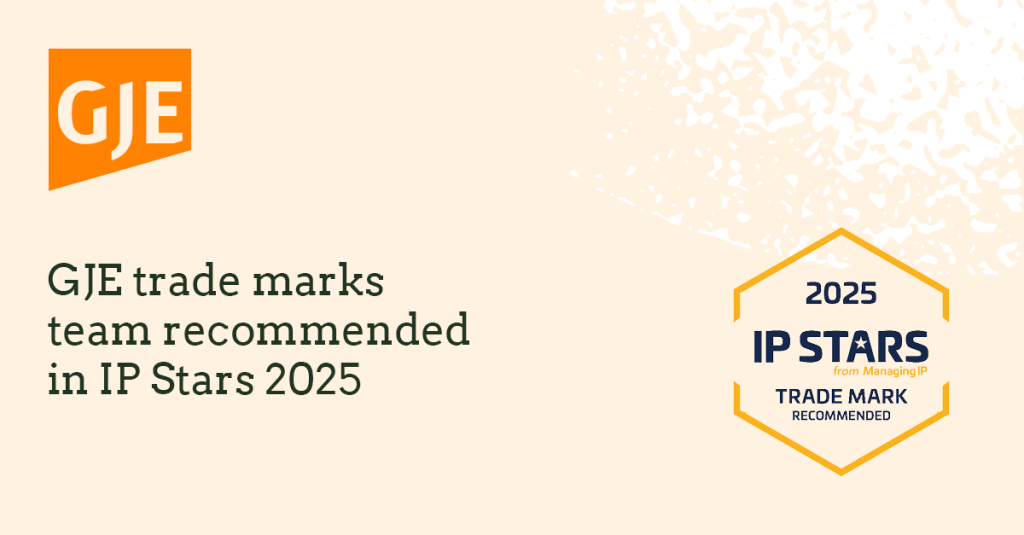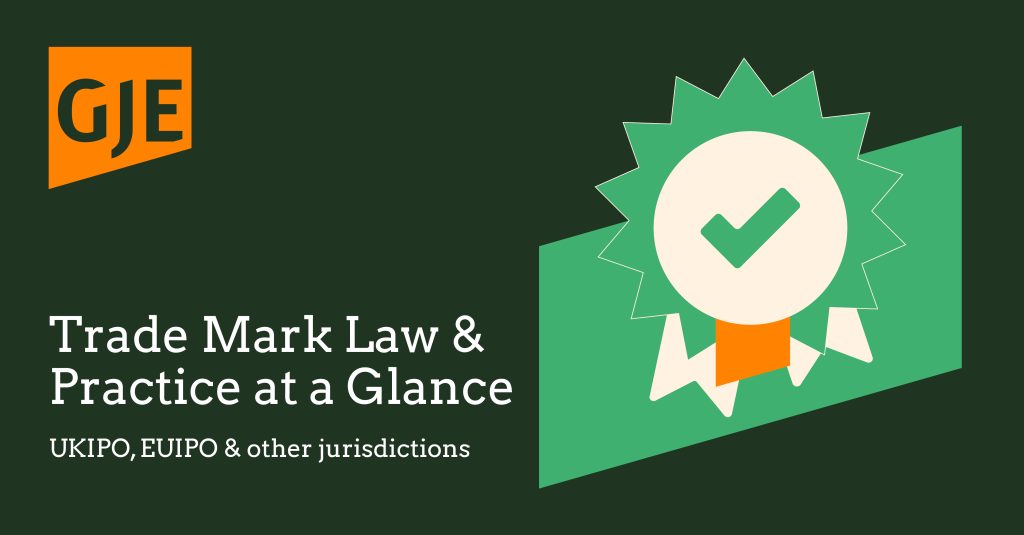Trade Mark services
You can find further information below.
Pre-filing advice/Clearance searches/Prosecution
Identifying and implementing an effective trade mark strategy should be one of the cornerstones of your IP plan, underpinning the wider commercial aims of your organisation.
Read more
Enforcement/Infringement/Passing off advice
A strong trade mark plays an important role in the success of your business. Our clients rely on us to protect the investment they have made in their trade marks.
Read more
Opposition/Cancellation
Opposition and cancellation proceedings are important elements of any brand strategy. We can help you manage them to keep trade mark registers free from conflicting marks.
Read more
Domain name disputes/Internet use
Domain name disputes including cybersquatting and disputes about trade marks have become extremely prevalent. With our insight, we'll ensure you are protected in this area.
Read more
Meet the trade marks team
Our trade marks team are on hand to help you develop the right strategy for your brand.
View full teamFrequently asked questions
How do I get a trade mark? Do I need a trade mark attorney?
From starting an application to having a trade mark granted, the registration process can take four to six months in the UK. Anyone can search existing trade marks and file their own. It’s worth noting that an initial search involves complex analysis to weigh up risks of potential conflicts, and the superficial simplicity of the trade mark filing process makes it easy to make mistakes that could leave the mark vulnerable to invalidation, or at least restrict its scope of protection. This is where a trade mark attorney will come into their own – and quite possibly save you a lot of money in the long run. A good trade mark attorney will help you identify and avoid potential conflicts and ensure that your trade mark protection is properly aligned to your long-term business strategy, taking into account possible expansion into new geographic markets or product categories.
What is a trade mark?
While a patent protects technology, a trade mark protects identity, as a distinctive guarantor of trade origin. In other words, a trade mark is a recognisable name, design, or expression that identifies a product or service marketed by a company and distinguishes it from products or services marketed by other companies. It could consist of a word, personal name, slogan, logo or even an animation, colour, or the shape of the goods or their packaging. As much as it’s crucial to develop a recognisable identity, it’s just as important to protect that identity appropriately to maximise its benefit. It’s important to note that simply buying a domain or registering a company name with Companies House doesn’t give you enforceable rights. A Companies House registration merely identifies a legal entity; rights arise only through the use of that name.
Am I free to use my trade mark?
There are 45 ‘classes’ relating to different goods and services. You register a trade mark within the classes relevant to your business. If another company has a trade mark identical or similar to yours for identical or similar goods or services, it will pose an infringement risk to your use and would be grounds to oppose any application that you file. Trade marks are not universal. Ownership of a mark in the UK, for instance, doesn’t entitle you to use or register it in other countries. If international expansion is part of your business strategy, you need to consider that when developing your brand. You’ll need to consider whether the relevant marks are available in the relevant classes in the markets you will be targeting. It might take longer to settle on a brand, but the extra effort will be worth it if you avoid having to change your brand wholesale, or wasting time and money building up recognition and trust of completely new brands. Finally, it’s not just registered marks you have to look out for. The UK and many other countries recognise unregistered rights in a mark arising through use. These unregistered rights can form the basis of a challenge to your use or application for registration.
Why do I need to register my trade mark?
There are three primary reasons to register a trade mark: First, registered trade marks have value in and of themselves, and can be attractive to investors – they can be an asset against which funds can be secured. In some cases, when a brand-led business is sold without any tangible assets such as property or inventory, trade marks may be the only store of value. Second, in those countries where unregistered rights are not recognised, it can be very difficult, or even impossible, to take action against a third party using, or trying to register, a mark that conflicts with you own. Finally, trade marks can help protect your brand, and your bottom line, from counterfeiting and black market trade. Registered trade marks can be recorded with customs authorities to enable suspect goods to be seized at the border.
Why do I need to search for existing trade marks?
Getting caught out can be costly. There are the legal costs you’ll incur defending yourself, penalties if you are found liable for infringing someone else’s rights, and the possibility of an injunction, not to mention damages or settlement costs. Then there’s the wasted expense of a brand that can’t be used, a possible product recall, the cost of creating a new brand, the potential loss of revenue if you are unable to operate in a specific market, negative publicity, and the loss of customer recognition as a result of having to change your brand.
Do I need a trade mark filing strategy?
In short: absolutely! A sound trade mark strategy, which involves knowing what you are going to need to protect, when and where you will be applying for that protection, and how having that protection will support your growth, is like the solid foundations for a house. It’s all about giving your company security and ensuring you can make smooth progress through the vital early stages of your growth. It will help you avoid any pitfalls such as costly rebrands or legal challenges at a point where they could sink you completely. And ultimately, getting brand protection right will safeguard your valuation when it comes to securing investment or seeking an exit. Research has repeatedly shown that as much as 70 per cent of the value of a company is attached to its brand rather than its tangible assets. When Nestle acquired the Rowntree business in 1988, for example, net assets accounted for just £300 million, most of the £2.55 billion price tag was in the earning potential of Rowntree’s popular brands, such as Kit Kat, Polo, and After Eight. Your brand is valuable because it’s the public face of your company. It creates associations and loyalty for consumers, who will pay a premium for a product from a company they know and trust.
Brexit - what does it mean for trade marks?
The UK has now left the EU, following a transition period that ended on 31 December 2020. This means that EU Trade Marks (EUTMs) and Registered Community Designs (RCDs) no longer offer protection in the UK. With regard to granted EUTMs, designations of EUTMs under the International registration system, RCDs and Hague designs designating the EUIPO, provided those were granted/registered as at 31 December 2020, the UK Intellectual Property Office (UKIPO) has created comparable rights on to the UK register allowing the protection to continue in the UK. Renewal fees for those newly created UK rights must be paid separately to retain protection. For those EUTMs and RCD applications that had been filed by 31 December 2020 and had not yet granted/registered it was possible for the owners to file a corresponding UK application by 30 September 2021 thereby retaining the filing or priority date of the EUTM or RCD application. Any corresponding UK application that is filed now will be given the date of actual filing. For any new EUTM or RCD application filed from 1 January 2021 onwards, a separate UK application must be filed in order to obtain protection in the UK. We have developed cost-effective filing packages to protect your business across both markets and are on hand to identify the strategy appropriate to your business.
How should I use my trade mark?
Trade marks should always be used as adjectives, not as nouns or verbs – to cite a classic example, “a Hoover vacuum cleaner” rather than “a Hoover” or “Hoovering”. Using a trade mark as a noun or verb can – as in the case of Hoover – lead over time to it becoming a generic term, rather than being a label of origin. If a trade mark becomes generic in this way, it becomes increasingly difficult to enforce registered rights against third parties and the mark may eventually be removed from the register following a challenge from a third party. Once your trade mark is registered, use the ® symbol. Before the registration is confirmed, or if you don’t have one, use the symbol ™. This alerts people to your rights and can serve as a warning that those rights will be enforced against inappropriate use.
Get in touch
If you are an ambitious business and you expect an IP service provider that can help you achieve your commercial objectives, then we want to work with you.
Complete this enquiry form and one of our specialists will be in touch within one working day. Alternatively, you can call us on +44 (0)20 7655 8500. We look forward to hearing from you.



